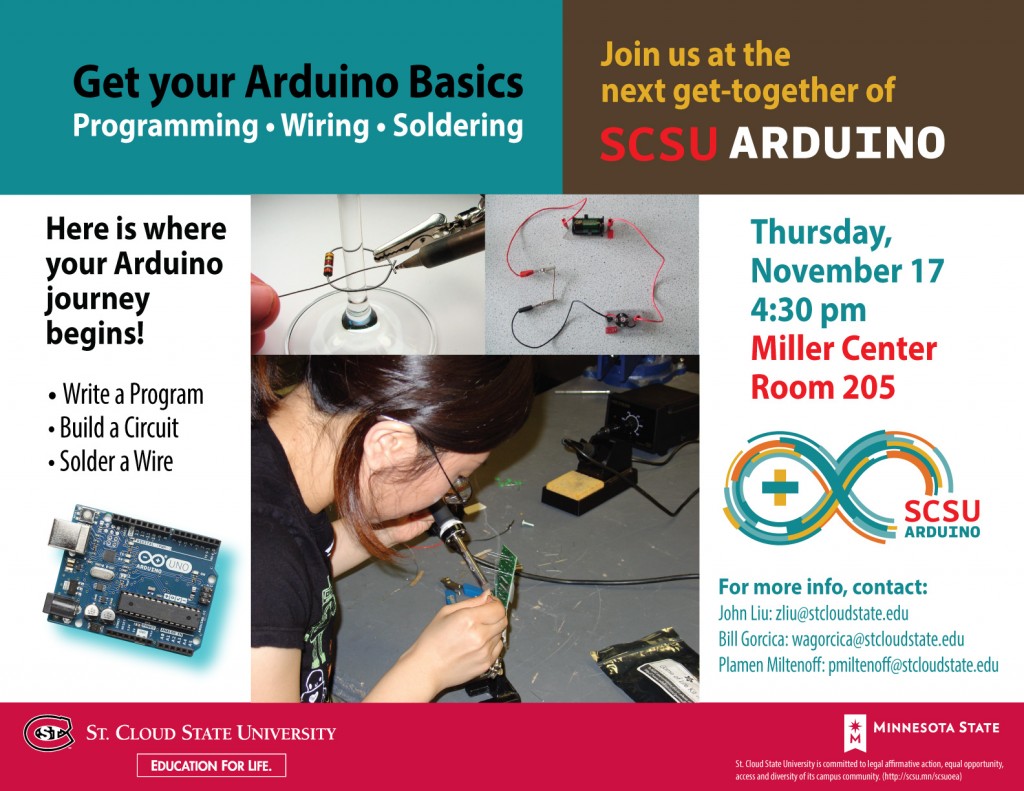Category Archives: Announcement
ArduiTouch
cupbox
Badges Kit for IoT activities
flexible Arduino
Air Force Research Laboratory has been working on a Flexible Arduino
Instead of working on expensive systems made out of highly robust parts developed in ultra-secure laboratories in top-secret locations, the AFRL has developed a functional flexible Arduino-compatible board, which they claim to be the first of its type.
Using a simplified flexible hybrid electronics manufacturing process, the Nextflex team reduced the number of manufacturing process steps by more than 60% and the weight of the Arduino board by 98%. The flexible Arduino has a thin, flexible plastic sheet as circuit board on which the microcontroller is mounted without its case. Digital printing processes were used to create the connections between the circuit elements.
Arduino as part of IoT
INTERNET OF THINGS CLASS
6 Lessons
http://www.instructables.com/class/Internet-of-Things-Class/
Lesson 1: Gather Your (Internet Of) Things
Lesson 2: Software Setup
Lesson 3: Hardware Setup
Lesson 4: Circuit Triggers Internet Action
Lesson 5: Circuit Displays Internet Data
Lesson 6: Combining Inputs and Outputs
Everyone Should Learn Arduino
4 Reasons Why Everyone Should Learn Arduino Now
http://www.makeuseof.com/tag/4-reasons-everyone-learn-arduino-now/
1. You Can Make Lots of Cool Stuff
2. It’s a Great Intro to Programming
3. It’s a Great Intro to Electronics, Too
4. It’s a Cheap Hobby to Get Into
arduino basics
IEEE student club Arduino presentation
IEEE student club presentation at 4pm in ISELF 118, October 18, 2016
https://youtu.be/UPsmGOqVf4M
bibliography on Arduino use in education
Please have a list of bibliography on Arduino use in education:
http://blog.stcloudstate.edu/ims/2016/10/13/bibliography-on-arduino-use-in-education/
Almeida Cavalcante, M. (2013). Novas tecnologias no estudo de ondas sonoras. Caderno Brasileiro De Ensino De Física, 30(3), 579-613.
Almeida Cavalcante, M., Tavares Rodrigues, T. T., & Andrea Bueno, D. (2013). CONTROLE REMOTO: PRINCIPIO DE FUNCIONAMENTO (parte 1 de 2). Caderno Brasileiro De Ensino De Física, 30(3), 554-565.
Atkin, K. (2016). Construction of a simple low-cost teslameter and its use with arduino and MakerPlot software. Physics Education, 51(2), 1-1.
Galeriu, C., Edwards, S., & Esper, G. (2014). An arduino investigation of simple harmonic motion. Physics Teacher, 52(3), 157-159.
Galeriu, C., Letson, C., & Esper, G. (2015). An arduino investigation of the RC circuit. Physics Teacher,53(5), 285-288.
Grinias, J. P., Whitfield, J. T., Guetschow, E. D., & Kennedy, R. T. (2016). An inexpensive, open-source USB arduino data acquisition device for chemical instrumentation. Journal of Chemical Education, 93(7), 1316-1319.
Kuan, W., Tseng, C., Chen, S., & Wong, C. (2016). Development of a computer-assisted instrumentation curriculum for physics students: Using LabVIEW and arduino platform. Journal of Science Education and Technology, 25(3), 427-438.
Kubínová, Š., & Šlégr, J. (2015). Physics demonstrations with the arduino board. Physics Education, 50(4), 472-474.
Kubínová, Š., & Šlégr, J. (2015). ChemDuino: Adapting arduino for low-cost chemical measurements in lecture and laboratory. Journal of Chemical Education, 92(10), 1751-1753.
Kubínova´, S., & S?le´gr, J. (2015). ChemDuino: Adapting arduino for low-cost chemical measurements in lecture and laboratory. Journal of Chemical Education, 92(10), 1751-1753.
López-Rodríguez, F. M., & Cuesta, F. (2016). Andruino-A1: Low-cost educational mobile robot based on android and arduino. Journal of Intelligent & Robotic Systems, 81(1), 63-76.
McClain, R. L. (2014). Construction of a photometer as an instructional tool for electronics and instrumentation. Journal of Chemical Education, 91(5), 747-750.
Musik, P. (2010). Development of computer-based experiment in physics for charging and discharging of a capacitor. Annual International Conference on Computer Science Education: Innovation & Technology, , I111-I116.
Pagliuca, G., Arduino, L. S., Barca, L., & Burani, C. (2008). Fully transparent orthography, yet lexical reading aloud: The lexicality effect in italian. Language and Cognitive Processes, 23(3), 422-433.
Park, S., Kim, W., & Seo, S. (2015). Development of the educational arduino module using the helium gas airship. Modern Physics Letters B, 29(6), -1.
Pereira, A. M., Santos, A. C. F., & Amorim, H. S. (2016). Estatística de contagem com a plataforma arduino. Caderno Brasileiro De Ensino De Física, 38(4), 1-8.
Sulpizio, S., Arduino, L. S., Paizi, D., & Burani, C. (2013). Stress assignment in reading italian polysyllabic pseudowords. Journal of Experimental Psychology: Learning, Memory, and Cognition, 39(1), 51-68.
Teikari, P., Najjar, R. P., Malkki, H., Knoblauch, K., Dumortier, D., Gronfier, C., et al. (2012). An inexpensive arduino-based LED stimulator system for vision research. Journal of Neuroscience Methods, 211(2), 227-236.
Walzik, M. P., Vollmar, V., Lachnit, T., Dietz, H., Haug, S., Bachmann, H., et al. (2015). A portable low-cost long-term live-cell imaging platform for biomedical research and education. Biosensors & Bioelectronics,64, 639-649.
Zachariadou, K., Yiasemides, K., & Trougkakos, N. (2012). A low-cost computer-controlled arduino-based educational laboratory system for teaching the fundamentals of photovoltaic cells. European Journal of Physics, 33(6), 1599-1610.
Zubrycki, I., & Granosik, G. (2014). Introducing modern robotics with ros and arduino, including case studies. Journal of Automation, Mobile Robotics & Intelligent Systems, 8(1), 69-75.
Пионкевич, В. А. (2016). ИНСТРУМЕНТЫ ДЛЯ ОБУЧЕНИЯ СОВРЕМЕННЫМ СРЕДСТВАМ ЦИФРОВЫХ СИСТЕМ АВТОМАТИЧЕСКОГО УПРАВЛЕНИЯ НЕТРАДИЦИОННЫМИ ИСТОЧНИКАМИ ЭЛЕКТРИЧЕСКОЙ ЭНЕРГИИ НА ОСНОВЕ МИКРОКОНТРОЛЛЕРОВ. Bulletin of Irkutsk State Technical University / Vestnik of Irkutsk State Technical University, (6), 136-145.
Please share your findings.

